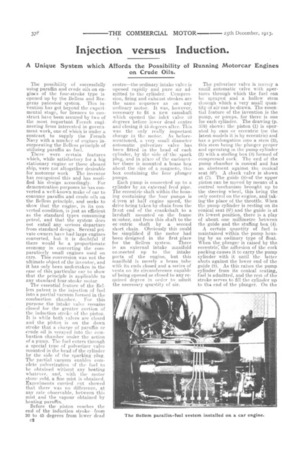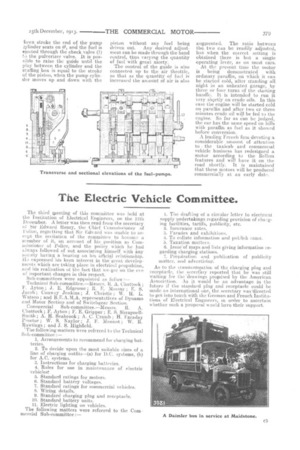Injection versus Induction.
Page 10

Page 11

If you've noticed an error in this article please click here to report it so we can fix it.
A Unique System which Affords the Possibility of Running Motorcar Engines on Crude Oils.
The possibility of successfully using paraffin and erode oils on engines of the four-stroke type is opened up by the Bellem and Bregeras patented system. This invention has got beyond the experimental stage, for licences to construct have been secured by two of the most important French engineering firms interested in government work, one of which is under a contract to supply the French Navy with a number of engines incorporating the Bellem principle of utilizing paraffin as fuel. There were certain features which, while satisfactory for a big stationary engine or those aboard ship, were not altogether desirable for motorcar work The inventor has recognized this and has modified his design accordingly. For demonstration purposes he has converted a well-known make of car to consume paraffin and crude oils on the Bellem principle, and seeks to show that the engine, in its converted condition, is just as efficient as the standard types consuming petrol, and that the system does not entail any serious departure from standard design. Several private owners have had large engines converted, but it is doubtful if there would be a proportionate economy in converting the cornpara,tively small engines used on cars. This conversion was not the ultimate object of the inventor, and it has only been undertaken in the case of this particular ear to show that the principle is applicable to any standard four-stroke motor.
The essential feature of the Bellem patent is the injection of fuel into a partial vacuum formed in the combustion chamber. For this purpose the intake valve remains closed For the greater portion of the induction stroke of the piston. It is while both valves are closed and the piston is on the down stroke that a charge of paraffin or crude oil is sprayed into the combustion chamber under the action of a pump. The fuel enters through a special type of pulverizer valve mounted in the head of the cylinder by the side of the sparking plug. The partial vacuum enables complete pulverization of the Niel to he obtained without any heating whatever, and, with the motor stone cold, a fine mist is obtained. Experiments carried out showed that there was no difference, at any rate observable, between this mist and the vapour obtained by heating paraffin.
Before the piston reaches the end of the induction strokefrom 30 to 45 degrees from lower dead c2
centre—the ordinary intake valve is opened rapidly and pure air admitted to the cylinder. Compression, firing and exhaust strokes are the same sequence as on any ordinary motor. It was, however, necessary to fit a new camshaft which opened the inlet valve 40 degrees before lower dead centre and closing it 45 degrees after. This was the only really important change in the motor. As beforementioned, a very small diameter automatic pulverizer valve has been fitted in the head of each cylinder, by the side of the spark plug, and in place of the carburetter there is mounted a brass box about the size of a magneto, this box containing the four plunger pumps.
Each pump is connected up to a cylinder by an external feed pipe. The eccentric shaft within the housing containing the four pumps is driven at half engine speed, the drive being taken by chain from the front end of the crankshaft to a layshaft mounted on the frame member, and from this shaft to the ec Tentric shaft by a second short chain. Obviously this could be simplified if the motor had been designed in the first place for the .Bellem system. There is an external intake manifold comected up to the intake ports of the engine, but this manifold is merely a brass tube with its ends closed and a series of vents on its circumference capable of being opened or closed to any required degree in order to admit the necessary quantity of air.
The pulveriser valve is tuen,iy small automatic valve with apertures through which the fuel can be sprayed and a hollow stem through which a very small quantity of air can be drawn. The essential feature of the invention is the pump, or pumps, for there is one for each cylinder. The drawing (p. 379) shows : the piston (1) is operated by cam or eccentric (on the latest models itis by eccentric) and has aprolongation into a stem (2), this stem being the plunger proper and operating in the pump cylinder (3) with a stuffing box (4) formed of compressed cork. The end of the pump chamber is conical and has an abutment against the conical seat (69. A check valve is shown at (7). The guide (8)of the upper piston can be moved by means of a control mechanism brought up to the steering wheel, this being the only control on the engine, and takingethe place of the throttle. When the pump cylinder is resting on its conical seat (61) and the guide is at its lowest position, there is a play of about. one millimetre between the guide and the stuffing box (4).
A certain quantity of fuel is maintained within the pump housing by an ordinary type of float. When the plunger is raised by the eccentric, • the adhesion of the cork packing causes it to carry the pump cylinder with it until the latter abuts against the lower end of the guide (8). As this raises the pump cylinder from its conical seating, fuel is admitted, and the rest of the stroke serves to fill the cylinder up to the. end of the plunger. On the limn stroke the end of the pump ;ylinder seats on 61, and the fuel is ejected through the check valve (7) to the pulverizer valve. It is possible to raise the guide until the play between the cylinder and the stuffing box is equal to the stroke of the piston, when the pump cylinder moves up and down with the
piston without any fuel being
driven out. Any desired adjustment can be made through the hand control, thus varying the quantity of fuel with great nicety.
The control of the guide is also connected up to the air throttle, so that as the quantity of fuel is increased the amount of air is also augmented. The ratio between the two can be readily adjusted, but when the correct setting is obtained there is but a single operating lever, as on most cars.
At the. present time the motor is being demonstrated with ordinary paraffin, on which it can be started cold, after s.tanding all night in an unheated garage, by three or four turns of the starting handle. It is intended to run it very shortly on crude oils. In this ease the engine will be started cold on paraffin and after two or three minutes crude oil will be fed to the engine. So far as can be judged, the car has the same speed on hills with paraffin as fuel as it showed before conversion.
A leading French firm devoting a considerable amount of attention to the taxicab and commercial vehicle business has redesigned a motor according to the Bellem features and will have it on the road shortly. It is maintained that these motors will be produced commercially at an early date.




















